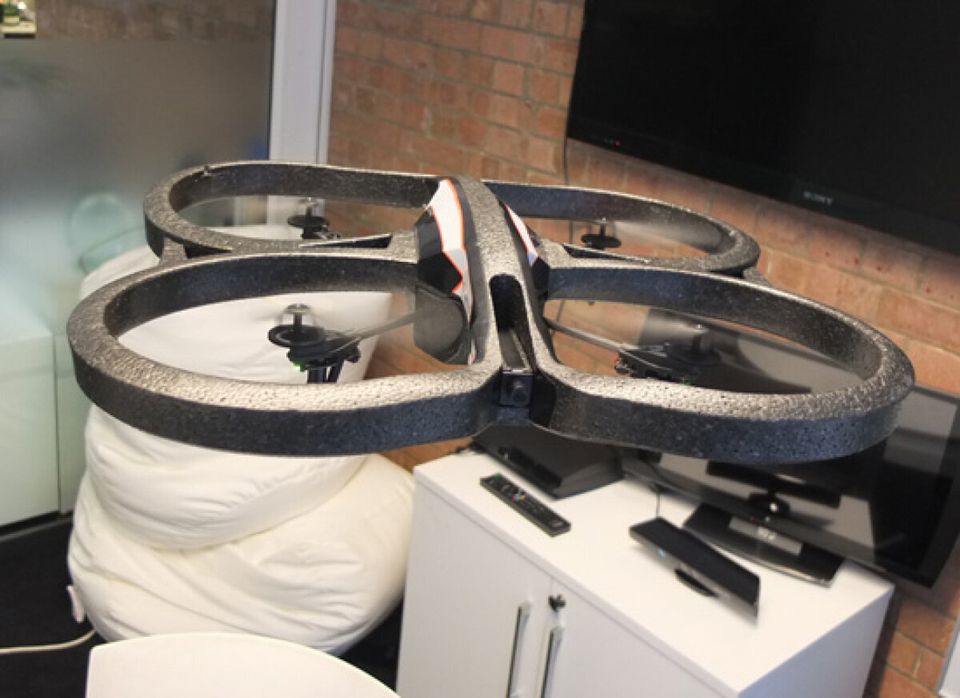The most important thing about the Parrot AR Drone 2.0 isn't that it's a lightweight quadcopter controlled through your phone.
It isn't that it has a (massively upgraded) HD camera on the front, or that every time you use one in public a crowd of at least half a dozen people will try and wrest it off you for a go.
It isn't even that you can record all of your piloting mishaps, close-shaves and dramatic manoeuvres right on to your phone for later viewing, and control it up to 160ft away and 20ft high -- all without looking up from the screen, like you're a tiny pilot in a nano-scale warplane.
No, the most important thing about the AR Drone 2.0 is that it works.
Let's start with specs. Roughly a foot-and-a-bit square, the 2.0 has four rotating blades and comes with two different hulls - an outdoor tube and an indoor foam shell - which weigh 380g and 420g respectively. The brain of the beast is a 1ghz, 32bit ARM processor, and it features both a three-axis accelerometer and a gyroscope. The hardware is complemented by lots of extremely clever ground and stability monitors to help keep the thing flying straight and true.
The camera on the drone's face is a 720p, 30FPS wide-angle joy which records both to a USB hard-drive (built-in) and the device with which you're controlling the craft.
It also takes still photos - which are decent enough quality - and has a low-res camera on the bottom, primarily used to measure speed which you can switch to mid-flight if you want to.
Elsewhere, the spec sheet reads like something from Mass Effect.
Phrases like 'self-lubricating bronze bearings', 'rare Earth magnets' and 'brushless inrunner motors' tumble from the side of the box like manna from nerd heaven, and the 'liquid repellent nano-coating' on the Drone's ultrasound sensors are brilliant precisely because we have no idea what they are or what they do do.
None of this matters, though, because the only important thing is that the drone is incredibly easy - and fun - to control.
Because the issue with many products of the AR Drone's type - roughly defined as toys for adults with spare cash, a fixation with gadgets and an unsettling desire to send synthetic minions into battle - is that they're often more frustrating than they are fun
Whether its an RC plane that turns out to have the build quality of a knock-off Scalextrix your dad bought at a car boot in the 80s, or a cheap, tiny helicopter which is more difficult to control than an actual army chopper, the list of disappointments is long and painful.
The AR Drone 2.0 is different. You want it to be easy, quick and deadly. And it is.
After connecting to your iOS or Android phone or tablet (we used an iPhone 4S) via a WiFi network which the drone create -, meaning you can use it anywhere - you're right in the pilot's seat via the included FreeFlight 2.0 app.
You press a button on the screen. the drone lifts up. Terrifyingly coy it waits a few feet in front of you, before you press another button and tilt your phone forward to drive the copter to glory.
From there it basically works as you imagine it should. Tilt to the phone side-to-side to strafe left and right, swivel the on-screen virtual thumbstick to pivot, raise up the stick to climb or lower the drone and press record to capture video. You can also double-tap to flip the drone over. Which is incredibly awesome, obviously.
True, getting the device to bank naturally like a plane is hard - this is a hover-and-move craft, after all. And we did crash - sorry, Parrot - now and again. Luckily all the bits are replaceable.
But 90% of the time the drone is sturdy, easy to land and intuitive to get out of trouble. Plus if you let go of the controller the drone will stop what it's doing and hover in mid-air. This is helpful if you're about to sheer the hair off the bloke from sales you've decided to 'buzz' on a dull Thursday afternoon.
The AR Drone 2.0 also comes with a selection of games - including a two-player pursuit mode, an AR combat game, a racing app and a cooperative mode.

Above: the guts of the beast.
Our only major issue with the Drone 2.0 was battery life. You're going to get 15 minutes play max out of an hour's charge, and unless you have a spare battery pack or a lot of patience that could get frustrating. The Drone's PR shots of a guy in the desert flying his copter are all well and good - but surely no one's slogging it out to Death Valley for a 12 minute flight?
Then there is the price. Latest word is the 2.0 Drone will cost around £280 when it's released - slightly lower than the 1.0 version, but still high. You'll have to decide whether having this much fun in 15-minute bursts is worth the cash.
To us, on payday, it probably is.
The highest praise we can give the Drone 2.0 is that it it's exactly as silly and ludicrous as you think it should be. This is tech that demands no explanation, requires no justification, and knows how to have fun. It's a gadget you want to use as a lift-drop to send Lego men into make-believe battle, teach to bring you a beer upstairs and use to spy on your co-workers.
And you basically can.
It made us smile, widely. In 15 minute bursts. Bravo.
